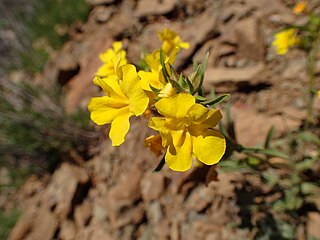
Coastal sage scrub, also known as coastal scrub, CSS, or soft chaparral, is a low scrubland plant community of the California coastal sage and chaparral subecoregion, found in coastal California and northwestern coastal Baja California. It is within the California chaparral and woodlands ecoregion, of the Mediterranean forests, woodlands, and scrub biome.

Arctostaphylos tomentosa is a species of manzanita known by the common name woollyleaf manzanita or woolley manzanita. This shrub is endemic to California.

Diplacus douglasii is a species of monkeyflower known by the common names brownies and purple mouse ears. It is native to the mountains and foothills of California and Oregon, where it is often found on serpentine soils. D. douglasii was first described in a published flora by George Bentham, an English botanist who was considered "the premier systematic botanist of the nineteenth century,." It was later described by Asa Gray, the father of North American botany.

Diplacus aridus, is a species of monkeyflower with yellow blossoms. It was formerly known as Mimulus aridus.

Diplacus brevipes is a species of monkeyflower known by the common name widethroat yellow monkeyflower. It was formerly known as Mimulus brevipes.

Diplacus clevelandii is an uncommon species of monkeyflower known by the common name Cleveland's bush monkeyflower. It was formerly known as Mimulus clevelandii.

Diplacus jepsonii, formerly classified as Mimulus nanus var. jepsonii, is a species of monkeyflower known by the common name Jepson's monkeyflower.

Diplacus mephiticus is a species of monkeyflower known by the common names skunky monkeyflower and foul odor monkeyflower. It was formerly known as Mimulus mephiticus.

Diplacus pictus is a species of monkeyflower known by the common name calico monkeyflower.

Diplacus whitneyi is a species of monkeyflower known by the common name Harlequin monkeyflower. It was formerly known as Mimulus lewisii. It is also known as Diplacus bicolor.

Clinopodium mimuloides is a species of flowering plant in the mint family known by the common name monkeyflower savory. It is endemic to California.

Diplacus puniceus, commonly known as the red bush monkeyflower, San Diego monkey flower, or mission diplacus, is a species of perennial shrub native to coastal southern California and northern Baja California. It is characterized by a relatively small and broad corolla for Diplacus, a lack of glandular hairs, and dark orange or red flowers, adapted to hummingbird pollinators.

Diplacus vandenbergensis, commonly known as the Vandenberg monkeyflower, is a species of Diplacus located in the Phrymaceae family. It grows as a small herbaceous annual plant and is native to the Burton Mesa Ecological Reserve in Santa Barbara County, California. According to the U.S. Fish and Wildlife Service it is an endangered species and hence was allocated critical habitat within the reserve in 2014.

Diplacus longiflorus, commonly known as southern bush monkeyflower, is a species of monkeyflower native to southwestern California and Baja California Norte (Mexico).

Erythranthe norrisii, formerly Mimulus norrisii, also known as Kaweah monkeyflower, is a species of flowering plant. Kaweah monkeyflower is endemic to the Kaweah River watershed of California in North America and is considered a rare species. Most specimens are known from Sequoia National Park in Tulare County. According to the Flora of North America Association, Kaweah monkeyflower grows in "steep marble outcrops in soil pockets, moss covered marble and quartzite ledges, cracks, fractures, weathered faces, chamise chaparral or blue oak woodlands."

Diplacus parviflorus, also known as the island bush monkeyflower, is a species of flowering plant endemic to California. This monkeyflower is an uncommon plant found only on four of the Channel Islands of California and in San Diego County. This plant sometimes hybridizes with Diplacus longiflorus. This species is attractive to butterflies including the western buckeye, mylitta crescent, and the variable checkerspot. This species was formerly considered part of the Mimulus aurantiacus species complex.
Diplacus brandegeei, also known as the Santa Cruz Island monkeyflower, is a species of flowering plant. This rare flower survives on Guadalupe Island in Mexico, but is believed to be extirpated on Santa Cruz Island in the United States, possibly because of livestock grazing. This plant has U.S. federal or California state protected status.

Diplacus calycinus, also known as the Kaweah River rock bush monkeyflower, is a species of flowering plant. This California endemic plant is usually found growing on granite outcrops, boulders, or rocky washes.

Diplacus parryi, also known as Parry's monkeyflower or annual red spot monkeyflower, is a species of flowering plant. This plant is native to southwestern North America. This monkeyflower produces both pink and yellow blossoms.

Diplacus ovatus, also known as steamboat monkeyflower, Carson monkeyflower, or eggleaf monkeyflower, is a species of flowering plant. This plant is only known from three locations in the U.S. state of Nevada, including Steamboat Hot Springs.



















